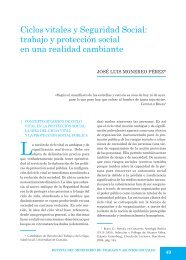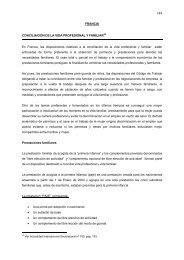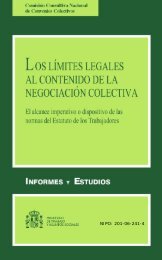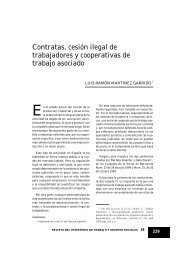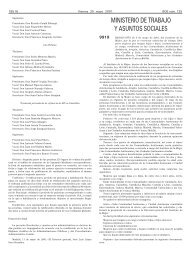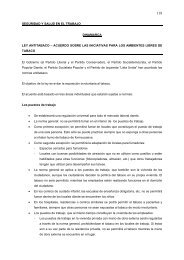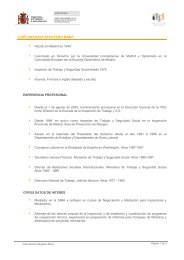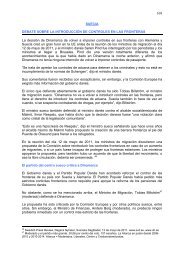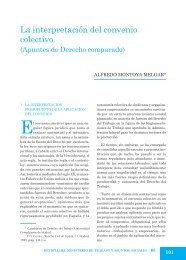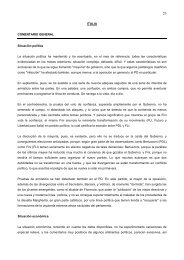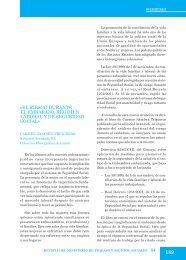Número 93: Derecho del Trabajo - Ministerio de Empleo y ...
Número 93: Derecho del Trabajo - Ministerio de Empleo y ...
Número 93: Derecho del Trabajo - Ministerio de Empleo y ...
You also want an ePaper? Increase the reach of your titles
YUMPU automatically turns print PDFs into web optimized ePapers that Google loves.
230<br />
INFORMES Y ESTUDIOS<br />
RESUMEN La retribución <strong><strong>de</strong>l</strong> personal laboral <strong><strong>de</strong>l</strong> sector público es uno <strong>de</strong> los aspectos en que menos<br />
cambios se produjeron con la aprobación <strong>de</strong> la Ley 7/2007, <strong>de</strong> 12 <strong>de</strong> abril, <strong><strong>de</strong>l</strong> Estatuto Básico<br />
<strong><strong>de</strong>l</strong> Empleado Público. Conforme a lo sugerido en el Informe <strong>de</strong> la Comisión para el estudio<br />
y preparación <strong><strong>de</strong>l</strong> EBEP, no se proce<strong>de</strong> a la equiparación por vía legal <strong><strong>de</strong>l</strong> personal laboral<br />
al funcionario, así que las retribuciones <strong><strong>de</strong>l</strong> personal laboral se fijan a través <strong>de</strong> la negociación<br />
colectiva y el contrato <strong>de</strong> trabajo, respetando las reglas <strong>de</strong> la legislación laboral<br />
común y los límites presupuestarios que puedan establecerse. Pues bien, partiendo <strong>de</strong> que<br />
el EBEP no modifica en esencia la situación preexistente, se abordan aquí las principales<br />
consecuencias <strong>de</strong> este hecho, <strong>de</strong>s<strong>de</strong> las limitaciones presupuestarias hasta el contenido y<br />
las ten<strong>de</strong>ncias que se observan en el tratamiento <strong><strong>de</strong>l</strong> salario <strong>de</strong> estos trabajadores en los<br />
convenios colectivos.<br />
De acuerdo con lo anterior se analiza la competencia <strong><strong>de</strong>l</strong> Estado para establecer límites al<br />
gasto público en materia <strong>de</strong> personal, algo que se estableció por primera vez en la Ley<br />
44/1983, <strong>de</strong> 28 <strong>de</strong> diciembre, <strong>de</strong> Presupuestos «disciplinarios» para 1984, que <strong>de</strong>spués se ha<br />
reproducido en las sucesivas leyes presupuestarias, y que ahora el art. 21 <strong><strong>de</strong>l</strong> EBEP regula<br />
con mayor <strong>de</strong>talle y corrección. A continuación una cuestión conectada a la anterior y que<br />
ha suscitado una importante controversia, la capacidad <strong><strong>de</strong>l</strong> Gobierno para incumplir los<br />
compromisos adquiridos en la negociación colectiva <strong><strong>de</strong>l</strong> personal laboral y, más en concreto,<br />
la vali<strong>de</strong>z <strong>de</strong> la reducción <strong><strong>de</strong>l</strong> salario <strong>de</strong> los empleados públicos llevada a cabo por el Real<br />
Decreto-Ley 8/2010, <strong>de</strong> 20 <strong>de</strong> mayo. Un aspecto que aborda un reciente auto <strong>de</strong> la Audiencia<br />
Nacional, y que le ha llevado a elevar cuestión <strong>de</strong> constitucionalidad ante el Tribunal<br />
Constitucional sobre si el citado Decreto-Ley ha vulnerado o no el contenido esencial <strong><strong>de</strong>l</strong><br />
<strong>de</strong>recho a la libertad sindical en relación con el <strong>de</strong>recho <strong>de</strong> negociación colectiva y el <strong>de</strong>recho<br />
a la igualdad. Finalmente se analizan tres aspectos relativos a la regulación <strong><strong>de</strong>l</strong> salario<br />
<strong><strong>de</strong>l</strong> personal laboral <strong><strong>de</strong>l</strong> sector público a través <strong>de</strong> los convenios colectivos: en primer<br />
lugar, las implicaciones que tienen que aplicar los convenios colectivos sectoriales a las<br />
administraciones públicas, en segundo lugar, la ten<strong>de</strong>ncia clara a establecer conceptos y<br />
cuantías económicas homogéneas entre el personal funcionario y el personal laboral a través<br />
<strong>de</strong> los convenios colectivos y, por último, el tratamiento que se hace <strong><strong>de</strong>l</strong> sistema retributivo<br />
<strong><strong>de</strong>l</strong> personal laboral <strong>de</strong> las Administraciones Públicas en la negociación colectiva.<br />
ABSTRACT The remuneration of contract personnel in the public sector is one of the aspects which<br />
suffered fewer changes with the adoption of Law 7/2007, of 12th April, on the Basic<br />
Statute of Public Employees. According to the suggestions ma<strong>de</strong> in the report by the Commission<br />
to study and elaborate the Basic Statute of Public Employees, contract personnel<br />
is not legally consi<strong>de</strong>red at the same level as public servants, so contract personnel's<br />
remunerations are <strong>de</strong>fined through collective agreement and employment contracts,<br />
abiding by common labour legislation rules and within the budgetary limits which could<br />
be established. This paper analyses the consequences of the fact that the Basic Statute of<br />
Public Employees does not, in essence, modify the existing situation, ranging from budgetary<br />
limitations to the content and ten<strong>de</strong>ncies observed in collective agreements with<br />
regards to these workers' salaries.<br />
Thus, the State's competence to establish limits to public expenditure in relation to staff is<br />
analysed, which was <strong>de</strong>fined, for the first time, by Law 44/1983, of 28th December, on «disciplinary»<br />
1984 budgets. Such limits were reproduced in the subsequent budgetary acts<br />
and are now regulated more accurately and in more <strong>de</strong>tail by article 21 of the Basic Statute<br />
of Public Employees. Then, a related and controversial issue is analysed, i.e. the capacity<br />
of the Government to break agreements reached in the contract personnel's collective<br />
agreement and, specifically, the validity of the salary reduction of public employees established<br />
by Royal Decree-Law 8/2010, of 20th May. This is tackled by a recent <strong>de</strong>cision by the<br />
National High Court, which has <strong>de</strong>rived in a referral being ma<strong>de</strong> to the Constitutional<br />
Court on whether the above Decree-Law has breached the essential content of the freedom<br />
of association right with regards to the collective bargaining right and the right of equality.<br />
Finally, three aspects related to the regulation of public sector contract personnel's<br />
salary through collective agreements are analysed: firstly, the implications of applying sectorial<br />
collective agreements to Public Administrations; secondly, the clear trend to establish<br />
concepts and homogenous economic quantities for civil servants and contract personnel<br />
through collective agreements; lastly, the manner in which collective bargaining <strong>de</strong>als<br />
with the remuneration system of Public Administrations contract personnel.<br />
REVISTA DEL MINISTERIO DE TRABAJO E INMIGRACIÓN <strong>93</strong>



